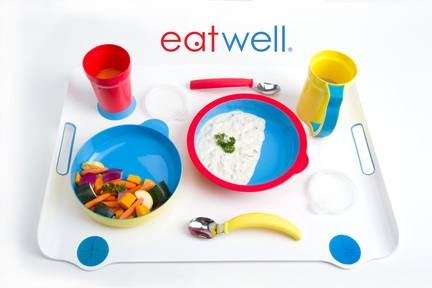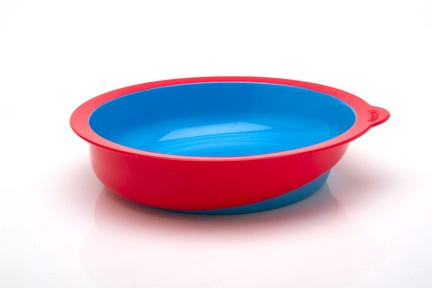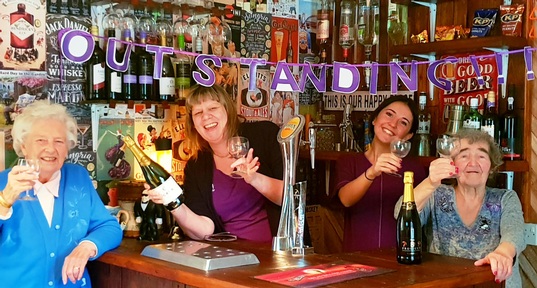Innovative tableware aids and encourages eating in people with dementia and motor impairment
A San Francisco based designer has created a range of tableware designed to offer a solution to people who struggle to eat due to physical disabilities and infirmities.

The Eatwell set was researched, designed and created by Sha Yao, who was inspired by her late grandmother who had Alzheimer’s disease.
She said: “Every time I looked at her, I wish I could have done something to help her. I believe there are many ways to improve the quality of life of our loved ones with progressive Alzheimer’s disease, as well as the lives of their care givers.”
The inspiration for Eatwell stemmed from both a personal connection of a relative living with Alzheimer’s and her interest in design to improve the world around her.
Eatwell was designed to increase food and drink intake and encourage better health and nutrition, maintain dignity and independence during meals and reduce the burden felt by care givers.
The project received more than $107,000 (approx £67,000) pledged in support and donations for the project through crowdfunding website Indiegogo and donations. People have expressed their support from all over the globe, either for a mention or to receive a copy of one of the first sets which are due for dispatch October this year.
Speaking about the success of the crowdfunding campaign and the publicity the project has received globally as a result, she said: “We have supporters across 35 countries worldwide that have pre-ordered our Eatwell assisted tableware set and we expect to begin delivering in October, 2015.”
’Eatwell is a universal tableware set that can be used by anyone’

Ms Yao’s project was recognised as one of seven finalists out of 52 in the Stanford’s Centre on Longevity Design Challenge 2014 and crowned the winner. The competition was launched in collaboration with Aging2.0 – a global initiative that aims to accelerate innovations for old people across the world.
She commented: “After winning the Stanford Design Challenge in 2014, we gained much more exposure and it helped us to reach a broader audience, but more importantly, it helped us to have a successful crowdfunding campaign and receive enough funding to make Eatwell a real product set that can be used by real users.”
The 20 features of the nine-piece-set are the result of more than four years’ worth of careful research and planning.
Eatwell sets contain an entire place setting designed for those with cognitive or motor impairments, specifically aimed at those with dementia. The design of a traditional place setting has been amended to feature bright colours, textures, weight and to make the food more appealing, while bright blue surfaces make food more visible.
Design can make a big difference in improving people's lives
The design features slanted bottoms to keep food together, making it even easier to scoop and weighted bottoms and skid-resistant materials to prevent spillages, while a placement has space for a napkin to catch any drips.

Ms Yao said: “Eatwell is a universal tableware set that can be used by anyone. Besides Alzheimer’s and other forms of dementia, it may also help people with motor impairments (like scleroses or palsies), or physical impairments (due to injury, infirmity or other conditions) by simplifying eating motions, reducing accidents, and increasing food intake for its users.
She continued: “I believe it can be a game changer in improving in the adult health and care industry. Many people with not just cognitive but also physical and motor impairments have encountered problems with eating and maintaining proper nutrition, but they might feel that it’s unavoidable, and that the situation can’t be improved. I hope to change that with my assistive tableware set.”
The brightly coloured design of the Eatwell set was inspired by research conducted by Boston University, which revealed that people living with dementia consume 24 per cent more food from brightly coloured receptacles and 84 per cent more liquid.
’The most non-technical solution can also make an immediate impact’
“Although many of our images depict two sets of Eatwell tableware sets, we want to clarify one thing. We suggest that care givers only serve food in one colour - either red or yellow - at a time. It can help our loved ones to concentrate on one eating or drinking task and avoid distraction. We also improve Eatwell by applying a matte finishing texture which makes Eatwell look even nicer and without showing any reflection which was suggested by many professional care givers as well.”

She added: “I am not trying to solve a single problem, but instead to do as much as possible to change the whole dining experience. I also use the most non-technical solution possible, which can also make an immediate impact.
The crowdfunding campaign has resulted in enough funding to make eight of nine pieces in the set, with the final piece, the Good Catch tray – due for manufacture next year and future plans to improve the set and adapt it for specific needs.
She added: “There are definitely additional features that we are considering adding in future models to address specific needs. We received lots of feedback requesting for us to design specialty products for a specific group of people, and we will definitely consider all opportunities to expand our product lines.”
Eatwell sets are available for pre-order from: www.eatwellset.com or through the Indiegogo campaign page: www.indiegogo.com/projects/eatwell-tableware-for-people-with-special-needs while orders are due to be shipped in October and will be retailed in early November.
Latest Innovative Care News
 13-May-19
'Pink drink' brain cancer treatment rolled out across NHS in memory of Baroness Jowell
13-May-19
'Pink drink' brain cancer treatment rolled out across NHS in memory of Baroness Jowell
 25-Apr-19
Louis Tomlinson helps 83-year-old who lost wife to dementia complete bucket list
25-Apr-19
Louis Tomlinson helps 83-year-old who lost wife to dementia complete bucket list
 22-Mar-19
UK's top care home handyman takes residents to pub for pie and pint
22-Mar-19
UK's top care home handyman takes residents to pub for pie and pint
 12-Feb-19
Michael McIntyre's jokes tested to see if they stop elderly catching flu
12-Feb-19
Michael McIntyre's jokes tested to see if they stop elderly catching flu
 07-Jan-19
'We were lucky to find it': Family's delight as care home is rated Outstanding
07-Jan-19
'We were lucky to find it': Family's delight as care home is rated Outstanding